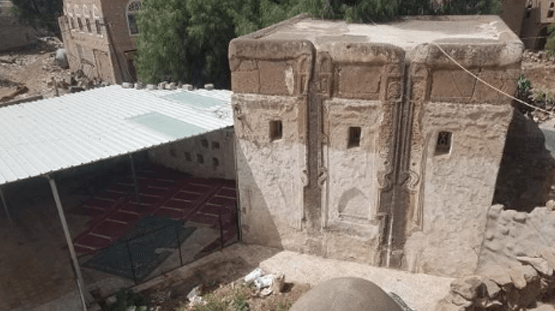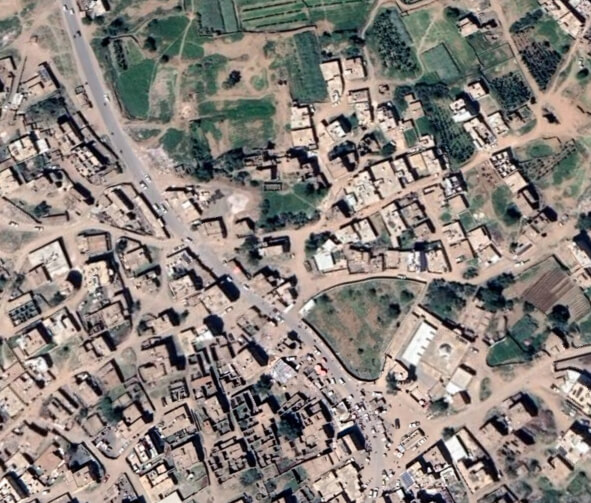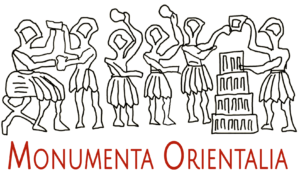
Al-‘Ābid Mosque – Old Ṣana‘ā’
مسجد العابد- صنعاء
Monument description
The Mosque consists of a Prayer Hall (Al-Baneah), a courtyard, an attached School, a room (Manzelah), an Ablution Anit, a pool, a well, and modern bathrooms. The Mosque and its annexes were built on a flat plain called Jerba, and the water of the Mosque’s well is from Al-A’sha village lands. The monument is surrounded by two blocks of houses which forms the village of Al-A’sha. The first block, the largest and probably the oldest, is located on the southeast side of the Mosque and at a distance of 90 m. The second block is adjacent to the Mosque from the north and west. The Mosque is currently located to the north of the asphalted road, and it is reached via a dirt road about 14 m long. The Mosque is used for the five obligatory prayers; a small School, which is known in Yemen as Al-Ma’lamah, is adjacent. The Mosque, the only one in the village, had a role as an educational center. There was a small mosque built in the 10th century AH next to Al-Ghafari House. This is one of the private and destroyed mosques, and only simple evidence remains of its pool (rest of Qudad), and a mound of ruins on the site.

Architectural and cultural value
Construction style and built date: The Mosque belongs to the group of small mosques called the ‘Cubic mosques’ such as Asnaf and Qidan mosques with ornate wooden ceiling. According to an inscription in a decoration of the wooden ceiling, the Mosque was built in 721 AH.
Components of the Mosque: The complex is composed by the Mosque, a courtyard, and annexes such as Al-Ma’lamah, the room, water system consisting of the Ablution Unit, a pond, and a well, and finally the tomb of the builder. The Area of the monument with the annexes is about 324 m2.
- Justifications for intervention:
- 1. Treatment and rehabilitation of a number of the damaged elements of the monument; a radical treatment of moisture problems, and the rehabilitation of abandoned spaces.
- Monument conditions and treatment:
-
Its condition is damaged and there are many damages that need urgent intervention to be restored, namely:
Urgent interventions for rescue:
1. Corrosion and breakage in the wooden ceiling and moisture-related damages of a number of decorations and inscriptions. Treatment: Rebuild a new waterproofing layer; Repair and seal cracks and holes in the surface; Chemical strengthening of organic elements, decorations and colors in the ceiling; Treatment and control of biological damage to roof wood.Works and interventions for damages that need restoration
1. Cracks in the dome’s walls. Treatment: Removal and replacement of the corroded Qudad layer; There are several treatment methods that are used according to the type and quantity of damage.2. The appearance of signs of moisture and corrosion in the wall of the toilet overlooking the courtyard, as well as the appearance of moisture from the outside on the part of the toilet due to humidity and the bad insulation. Treatment: Isolate the water pipes used for ablution, as well as separate the bathrooms in order to avoid moisture.
3. Cracks and erosion in the dome. Treatment: Skimming of the corroded Qudad layer; Replacement of a Qudad layer. There are several treatment methods that are used according to the type and quantity of damage.
-
4. Plaster falling over the wood covering the ceiling in Al-Ma’lamah. Treatment: Skimming of the corroded Qudad layer; Addition of a layer of Qudad for the worn out parts. There are several treatment methods that are used according to the type and quantity of damage.
5. Cracks and erosion of the outer wall of the Mihrab. Treatment: Bracing the wall of the facade before removing the stones. If the area of the bulged wall is small, the stones are removed without the need for bracing. After dismantling and removing the stones, the center of the wall is cleaned of broken stones and loosened mortar; Connecting joints shall be placed that connect the two surfaces of the wall together and prevent their separation in the future, and stones or wooden beams can be used for this purpose; Reuse the stones, filling the center of the wall with the appropriate mortar and small stone fractions.
6. Corrosion in the Qudad layer as well as the collapse of parts of it due to moisture in the western elevation of the Prayer Hall. Treatment: Skimming of the corroded Qudad layer; Addition of a layer of Qudad for the worn out parts. There are several treatment methods that are used according to the type and quantity of damage.
7. Ma’lamah roof collapse, currently used as a firewood store. Supply and installation of wooden beams, reusing the old ones, if possible; Covering with layers of mud and Qudad.
8. Damage of some parts of the plaster layer of the outer wall of the room. Removal and replacement of the corroded Qudad layer. There are several treatment methods that are used according to the type and quantity of damage.

Countries







